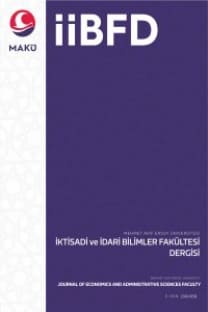TÜRK ÜNİVERSİTE WEBSİTELERİ, ULUSLARARASI ÖĞRENCİLERİN BİLGİ İHTİYAÇLARINI KARŞILAMA NOKTASINDA İŞLEVSEL Mİ?
Türk Üniversiteleri, Uluslararası Öğrenciler, Üniversite Web Siteleri, Turkish Universities, International Students, University Websites
ARE TURKISH UNIVERSITY WEBSITES FUNCTIONAL TO MEET THE INFORMATIONAL NEEDS OF INTERNATIONAL STUDENTS?
___
- Baumgartner, J. L. (2018). NAFSA International Student Economic Value Tool. NAFSA: Association of International Educators. https://www.nafsa.org/sites/default/files/media/document/isev-methodology-2020.pdf (29.06.2022)
- Bevis, T. B., and Lucas, C. J. (2007). International Students in American Colleges and Universities: A History. Palgrave Macmillan, NY.
- Charles, P. C. (1999). Common Stressors Among International College Students: Research and Counseling Implications. Journal of College Counseling, vol. 2.
- Choudaha, R. (2019). Beyond 300 Billions: Th Global Impact of International Students. StudyPortas. https://studyportals.com/intelligence/global-impact-of-international-students. (16.07.2022)
- De Wit, H. (2008). The Internationalization of Higher Education In A Global Context. In H. de Wit, P. Agarwal, M.E. Said, M.T. Sehoole ve M. Sirozi (Editörler), The Dynamics of International Student Circulation in a Global Context. Rotterdam: Sense Publishers.
- Hechanova-Alampay, R., Beehr, T. A., Christiansen, N. D & Van Horn, R.K. (2002). Adjustment and Strain among Domestic and International Student Sojourners: A Longitudinal Study. School Psychology International, Vol. 23(4)
- Farrugia, C., Sanger, J. (2017). Gaining an Employment Edge: The Impact of Study Abroad on 21st Century Skills & Career Prospects in the United States. Institute of International Education (IIE). https://www.iie.org/Research-and-Insights/Publications/Gaining-an-employment-edge---The-Impact-of-Study-Abroad (16.06.2022)
- Irwin, V., De La Rosa, J., Wang, K., Hein, S., Zhang, J., Burr, R., Roberts, A., Barmer, A., Bullock Mann, F., Dilig, R., Parker, S. (2022). Report on the Condition of Education 2022 (NCES 2022-144). U.S. Department of Education. Washington, DC: National Center for Education Statistics. https://nces.ed.gov/pubs2022/2022144.pdf (08.04.2022)
- London Economics (2021). The costs and benefits of international higher education students to the U.K. economy. London Economics. https://londoneconomics.co.uk/wp-content/uploads/2021/09/LE-HEPI-UUKi-Impact-of-intl-HE-students-on-the-UK-economy-Summary-Report-September-2021.pdf. (28.08.2022)
- NAFSA: Association of International Educators. (2019, 2022). International Student Economic Value Tool. https://www.nafsa.org/policy-and-advocacy/policy-resources/nafsa-international-student-economic-value-tool-v2#trends_reports. (02.05.2022)
- NCES: National Center for Education Statistics. (2022). Report on the Condition of Education 2022. U.S. Department of Education. Washington, DC: National Center for Education Statistics. https://nces.ed.gov/pubs2022/2022144.pdf
- NCES, (2022). National Center for Educational Statistics. https://nces.ed.gov/programs/coe/pdf/2022/cha_508.pdf (11.07.2022)
- OECD. (2008). Education at Glance, OECD. https://www.oecd.org/education/skills-beyond-school/41284038.pdf. (8.08.2022)
- OECD. (2014). Education at a Glance 2014, OECD indicators. https://www.oecd.org/education/Education-at-a-Glance-2014.pdf. (8.08.2022)
- OECD. (2021). Education at a Glance 2021: OECD Indicators. OECD Publishing, Paris. https://doi.org/10.1787/b35a14e5-en. (8.08.2022)
- Open Doors. (2022). Presentation 2022. Retrieved from https://opendoorsdata.org/annual-release/international-students.
- Özöğlu, M., Gür, B.S., Coşkun, İ. (2015). Factors influencing international students' choice to study in Turkey and challenges they experience in Turkey. Research in Comparative & International Education, 10(2), Sage.
- Peker, S., Kucukozer-Cavdar, S., Cagiltay, K. (2016), Exploring the relationship between web presence and web usability for universities: A case study from Turkey. Program: electronic library and information systems, 50(2).
- Poyrazli, S., Kavanaugh, P. R., Baker, A., Al-Timimi, A. (2004). Social Support and Demographic Correlates of Acculturative Stress in International Students. Journal of College Counseling, Spring, 7.
- Project Atlas (2020). A Quick Look At Global Mobility Trends. https://iie.widen.net/s/g2bqxwkwqv/project-atlas-infographics-2020 (9.10.2021)
- Project Atlas (2015). A Quick Look At Global Mobility Trends. https://iie.widen.net/s/9sdq8lfdk8/project-atlas-infographics-2015 (9.10.2021)
- Radmard, S. (2017). Türk Üniversitelerindeki Uluslararası Öğrencilerin Yükseköğretim Taleplerini Etkileyen Etkenlerin İncelenmesi. Yükseköğretim ve Bilim Dergisi, 7(1).
- Saichaie, K., Morphew, C. (2014). What College and University Websites Reveal about the Purposes of Higher Education. The Journal of Higher Education, 85(4), 499-530.
- Taylor, Z. W. (2018). Intelligibility is equity: Can international students read undergraduate admissions materials? Higher Education Quarterly, 72(2).
- Taylor. Z. W., Bıcak, I. (2019). International, Inaccessible, and Incomplete: A Texas Case Study of International Student Websites. Journal of International Students, 9(4).
- Taylor, Z. W., Bıcak, I. (2018). Institutional, Informational, International: Predicting International Student Enrollment and Rate by Online Information. Journal of Comparative and International Higher Education, 10 (2018).
- T.C. Kalkınma Bakanlığı (2013). Onuncu Kalkınma Planı 2014-2018.
- Tutar, H. (2010). Bir Kültürel Diplomasi Örneği Olarak Büyük Öğrenci Projesi, (Editörler: Osman Bahadır Dinçer, Habibe Özdal, Hacali Necefoğlu), Yeni Dönemde Türk Dış Politikası: Uluslararası IV. Türk Dış Politikası Sempozyumu, Kars Kafkas Üniversitesi ve Uluslararası Stratejik Araştırmalar Kurumu.
- Yeh, C. J., Inose, M. (2003). International students' reported English fluency, social support satisfaction, and social connectedness as predictors of acculturative stress. Counselling Psychology Quarterly, 16(1).
- Yurtdışı Türkler ve Akraba Topluluklar Başkanlığı (YTB) Teşkilat ve Görevleri Hakkında Kanun. Resmi Gazete, Kanun No: 5978, Tarihi, 06.04.2010, Madde 3/d.
- Yükseköğretim Kurulu. (2017). Yükseköğretimde Uluslararasılaşma Strateji Belgesi 2018-2022. Yükseköğretim Kurulu Yayınları, Ankara.
- Yükseköğretim Kurulu (YÖK). (2021). Yüseköğretimde Yeni YÖK Projeleri: Yükseköğretimde Hedef Odaklı Uluslararasılaşma. Yükseköğretim Kurulu Yayınları.
- Yükseköğretim Kurulu (YÖK). (2021b). Vakıf Yükseköğretim Kurumları Raporu, 2021. Yükseköğretim Kurumu Yayınları, Ankara.
- Yükseköğretim Kurulu (2022). Yükseköğretim İstatistik verileri, 2020/2021. https://istatistik.yok.gov.tr (17.7.2022)
- Yılmaz, G., Nezahat, G. (2021). Türkiye’de Uluslararası Öğrenci Hareketliliğinin Görünümü. Yükseköğretim ve Bilim Dergisi, 11(1).
- Zhou, E., Gao, J. (2021). Graduate Enrollment and Degrees: 2010 to 2020. Washington, DC: Council of Graduate Schools.
- Zengin, B., Arıkan, A., Doğan, D. (2011). English Major Students' Opinions of Their Departments' Websites. Contemporary Educational Technology, 2011 2(4).
- ISSN: 2149-1658
- Yayın Aralığı: 4
- Yayıncı: Mehmet Akif Ersoy
Sumeyra SARIDAĞ, Hamza Bahadır ESER
Hüseyin TOPUZ, Hüseyin Ali ERSOY
AŞILAMANIN COVID-19 ÖLÜMLERİNE ETKİSİ: ÜLKELERİN GELİR GRUPLARINA GÖRE BİR ARAŞTIRMA
Osman ŞENOL, Ümit ÇIRAKLI, Durmuş GÖKKAYA
YÜKSELEN EKONOMİLERDE ENERJİ ETKİNLİLİĞİNİ ETKİLEYEN FAKTÖRLER: KARMA MODELLER
Mustafa NAİMOĞLU, Mustafa AKAL, Çisem BEKTUR
COVID-19 SÜRECİNDE SEÇİLMİŞ ÜLKELERDE VE TÜRKİYE’DE KREDİ RİSKİNİN BELİRLEYİCİLERİ
BELEDİYELERDE TOPLAM KALİTE YÖNETİMİN KURULMASI İÇİN YAPILMASI GEREKENLER ÜZERİNE BİR ARAŞTIRMA
TURİZM SEKTÖRÜNDE BUMERANG YÖNETİCİLER: NEDEN GİTTİLER? NEDEN DÖNDÜLER?
Pınar ÇELİK ÇAYLAK, Nisa EKŞİLİ, Cenk TUFAN
YEŞİL İŞLER ÜZERİNE YAPILAN ÇALIŞMALARIN BİBLİYOMETRİK ANALİZ YÖNTEMİ İLE İNCELENMESİ
Şerife DURMAZ, Aydın ÇİVİLİDAĞ, Murşit IŞIK
İSTANBUL SÖZLEŞMESİNİN ANALİZİ VE KADINA YÖNELİK ŞİDDETİN ÖNLENMESİ İÇİN POLİTİKA İLKELERİ ÖNERİSİ
